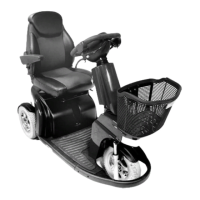4.6 TYRES:
The tyres of a scooter suffer wear depending on how
much the scooter is used. Check them regularly,
especially for inflation pressure, according to the service
instructions in this manual.
Each tyre pressure should be:
Elite2 XS & RS = 1.8-2.0 bar (25-28 P.S.I.)
Elite2 Plus = 2.4-2.5 bar (33-35 P.S.I.).
See section 5.26 for solid tyre information.
DANGER!
Never inflate the tyres with a service station air pump. It
is recommended that you use a manual pump or a
pressure regulator (manometer)
4.7 FREEWHEEL DEVICE, (FIG.4.2):
The scooter has two modes of movement:
Drive or Freewheel.
DRIVE = All movement, including braking, is •
exclusively controled by operation of the electronic
control system.
FREEWHEEL = Movement is by manual means. •
Movement can also occure due to gravity, (pot holes,
kerbs, hills or inclines etc).
Push the lever up for drive and down for freewheel.
DANGER!
Only use the freewheel function to push the scooter •
manually from one spot to another.
Keep in mind that while the freewheel system is in •
operation, the scooter is without a braking system.
Selecting freewheel causes a loud audible warning •
beeping tone from the scooter horn.
For safety reasons the scooter can no longer be •
moved using the control levers.
Do not operate the freewheel device whilst seated in •
the scooter
The freewheel device should only be operated by a •
person who has the strength and agility to be able to
fully manoeuvre the scooter safely, during freewheel.
Always put the scooter back in drive.•
Always check that drive is engaged before using the •
scooter.
Do not disengage the freewheel on or near a slope.•
Do not allow yourself to be pushed by others whilst •
the scooter is in freewheel.
4.8 TRANSPORTATION IN VEHICLES:
This scooter is suitable to use as a seat in vehicles as per
certificate ISO / NP 7176-19: 2008, and using the
restraint system Unwin (4 point WWR / ATF / K / R) or
any other 4 point tie down system that complies to the
same standards.
DANGER!
A scooter secured in a vehicle will not provide the
equivalent level of safety and security of a vehicle seating
system. It is always recommended that the user transfers
to the vehicle seating. It is recognised that this is not
always practical for the user to be transferred and in
these circumstances where the user must be transported
whilst in the scooter the following advice should be
followed:
WARNING!
Confirm that the vehicle is suitably equipped to •
transport a passenger in a scooter, and ensure the
method of access/egress is suitable for your scooter
type.
The vehicle should have the floor strength to take the •
combined weight of the user, the scooter and
accessories.
Sufficient space should be available around the •
scooter to enable clear access to attach, tighten and
release the scooter and occupant tie down restraints
and safety belts.
The occupied scooter must be located in a forward •
facing position and secured by the scooter tie down
and occupant restraint straps (WTORS tie downs)
meeting the requirements of ISO 10542 or SAE
J2249, in accordance with the WTORS
manufacturers’ instructions, (Fig. 4.3).
The scooter’s use in other positions within a vehicle •
has not been tested e.g. transportation in a side
facing position must not be carried out under any
circumstances. (Fig. 4.3).
The scooter should be secured by a Tie Down •
Restraint system, conforming to ISO 10542 or SAE
J2249 with non-adjustable front straps and adjustable
rear straps, which typically use Karabiner clips/S
hooks and tongue and buckle fittings. These
restraints generally comprise of 4 individual straps
that are attached to each corner of the scooter.
Fig.4.3
Fig.4.2
DRIVE
FREEWHEEL

